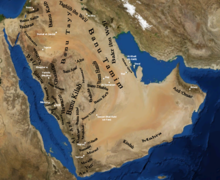Banū Sulaim

The Banū Sulaim ( Arabic بنو سليم) were an ancient Arab tribe of the Hejaz , who played an important role in the conflict between Muhammad and the Quraish and still had a certain importance in the first Islamic centuries. The associated Nisba is Sulamī .
The Banū Sulaim are counted among the North Arabian tribes and in the Arabic genealogy traced back to Ishmael , the son of Abraham , through the lineage of Sulaim ibn Mansūr ibn ʿIkrima ibn Qais ʿAilān ibn Mudar ibn Nizār ibn ʿAdnān ibn Maʿadd .
Situation in pre-Islamic times
The main residential area of the Banū Sulaim was a high basalt field ( ḥarra ) south of Medina , which was called Harrat Banī Sulaim and on the eastern and western slopes of which there were protected grazing grounds, called Himā . Since almost all communication routes in the Hijaz led through the areas of the Banū Sulaim, the tribe was of great strategic importance. Within the tribe there were three departments, the Imruʾ al-Qais, who lived on the eastern slopes of the Harra, the Hārith on the western slopes of the Harra and the Thaʿlaba, whose residential area cannot be determined. A well-known poet and fighter of the Banū Sulaim was al-ʿAbbās ibn Mirdās, who belonged to the Harith. His poetry is also an important source for the situation among the Banū Sulaim.
Many of the Banū Sulaim were active in agriculture in pre-Islamic times, and there was also a gold mine in the Imruʾ al-Qais area . At this gold mine lived a tribal group of the Balī, which actually belonged to the Federation of Qudāʿa , but felt connected to the Banū Sulaim. The Banū Sulaim worshiped various ancient Arabic deities , including the stone idol al-Chamīs . A member of the Harith provided the last guardian of the sanctuary of al-ʿUzzā .
Transition to Islam
At the beginning of the 7th century, the Banū Sulaim maintained good relations with both Mecca and Yathrib . Allied with Mecca were the Banū Dhakwān, who belonged to the department of the Thaʿlaba and had married into some of the most important families of the Quraish . ʿAmr ibn ʿAbasa, a man from the Mālik ibn Thaʿlaba, was said to be one of the earliest followers of Muhammad.
With the Chazradsch tribe from Yathrib, the Banū Sulaim connected above all the common veneration of the stone idol al-Khamīs. After Muhammad's entry into Yathrib, however, the relationship between the Banū Sulaim and Yathrib deteriorated. Shortly after the Battle of Badr , in October / November, the Muslims undertook a first expedition against the Banū Sulaim, although there was no military confrontation. In July 625, the Banū Sulaim took part in the massacre of Bi'r Maʿūna, in which a large number (29-70) of Koran readers were murdered. As a result, Mohammed is said to have cursed the Banū Sulaim daily during the morning prayer in the form of the Qunūt until Sura 3: 169 was revealed. Even in the battle of the trenches , the Banū Sulaim were still hostile to the Muslims and cooperated with the Quraish. When Mohammed took Mecca in January 630, all or at least some of them were already on his side. The number of Banū Sulaim who were Muslims present at this event is given as 700 to 1000.
Story after the death of Muhammad
During the Ridda Wars after the Prophet's death, some clans of the Banū Sulaim turned away from Islam again, including in particular the ʿUsaiya belonging to the Imruʾ al-Qais, but the tribe soon played an important role in the Arab conquest of Iraq and Syria a. Many members of the tribe settled in Kufa , Basra , Khorasan and Egypt. In 869 a member of the Banū Sulaim, Hāschim ibn Surāqa, became the ruler of Derbent and made himself independent from the Abbasids . His descendants, the so-called Hāschimiden, ruled the city and its surroundings until 1077.
In their original settlement area between Mecca and Medina, the Banū Sulaim were absorbed by the Harb. The Banū Sulaim of Egypt emigrated together with the Banu Hilal to the Maghreb in the 12th century , where they pushed the Berbers into the background politically.
literature
- Werner Caskel: Ǧamharat an-nasab: the genealogical work of Hišām Ibn Muḥammad al-Kalbī . 2 Vols. Brill, Leiden, 1966. Vol. I, plates 122-125. - Vol. II, pp. 18f., 517.
- Michael Lecker: The Banū Sulaym. A Contribution to the Study of Early Islam. Jerusalem 1989.
- Michael Lecker: Art. "Sulaym" in The Encyclopaedia of Islam. New Edition Vol. IX, pp. 817-818.
- W. Montgomery Watt: Muhammad at Medina . Oxford 1956. pp. 95-97.
Individual evidence
- ↑ See Lecker 1989, 229-238.
- ↑ Cf. on him GE von Grunebaum: Art. "Al-ʿAbbās ibn Mirdās" in The Encyclopaedia of Islam. New Edition Vol. I, p. 12.
- ↑ See Lecker 1989, 183–201.
- ↑ See Lecker 1989, 108-119.
- ↑ See Lecker: The Banū Sulaym. 1989, pp. 74, 94f.
- ↑ See Watt 96.
- ↑ Cf. Ibn Hischām : Kitāb Sīrat Rasūl Allāh. From d. Hs. On Berlin, Leipzig, Gotha a. Leyden ed. by Ferdinand Wüstenfeld. 2 vols. Göttingen 1858-59. P. 828. Digitized
- ↑ Lecker in Encyclopaedia of Islam Vol. IX, p. 818a.
- ↑ See Vladimir Minorsky: A History of Sharvan and Darband in the 10th-11th Centuries . Cambridge 1958. pp. 20, 41.
- ↑ Lecker in Encyclopaedia of Islam Vol. IX, p. 818b.